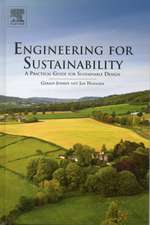CAAD futures 1997: Proceedings of the 7th International Conference on Computer Aided Architectural Design Futures held in Munich, Germany, 4–6 August 1997
Editat de Richard Jungeen Limba Engleză Paperback – 13 noi 2012
Proceedings of CAAD futures held biannually provide a complete review of the state of research in Computer Aided Architectural Design.
Preț: 441.50 lei
Nou
Puncte Express: 662
Preț estimativ în valută:
84.49€ • 87.88$ • 69.75£
84.49€ • 87.88$ • 69.75£
Carte tipărită la comandă
Livrare economică 10-16 aprilie
Preluare comenzi: 021 569.72.76
Specificații
ISBN-13: 9789401063500
ISBN-10: 9401063508
Pagini: 976
Ilustrații: XVIII, 931 p.
Dimensiuni: 155 x 235 x 51 mm
Ediția:Softcover reprint of the original 1st ed. 1997
Editura: SPRINGER NETHERLANDS
Colecția Springer
Locul publicării:Dordrecht, Netherlands
ISBN-10: 9401063508
Pagini: 976
Ilustrații: XVIII, 931 p.
Dimensiuni: 155 x 235 x 51 mm
Ediția:Softcover reprint of the original 1st ed. 1997
Editura: SPRINGER NETHERLANDS
Colecția Springer
Locul publicării:Dordrecht, Netherlands
Public țintă
ResearchCuprins
Keynote Papers.- Design Medium — Design Object.- CAD — So What?.- Integration of Design Applications with Building Models.- What Are We Learning from Designers and Its Role in Future Caad Tools.- Shapes, Grammars and Types.- Grammars and Art.- Spatium — A System for the Definition and Design of Shape Grammars.- Architectural Design-By-Features.- Generic Representations: Typical Design without the Use of Types.- Design Support.- ARMILLA5 — Supporting Design, Construction and Management of Complex Buildings.- Improving Caad by Applying Integrated Design Support Systems and New Design Methodologies.- Regulating Lines and Geometric Relations as a Framework for Exploring Shape, Dimension and Geometric Organization in Design.- Computability of Design Diagrams.- Hand-Eye Coordination in Desktop Virtual Reality.- A Digital Way of Planning Based on Information Surveying.- Exploration and Evaluation.- Tools for Visual and Spatial Analysis of CAD Models.- Design Conversations with Your Computer: Evaluating Experiential Qualities of Physical Form.- Modeling-Assisted Building Control.- On the Problem of Operative Information in CAAD.- On the Evaluation of Architectural Figural Goodness.- Human-Computer Interaction and Neural Networks in Architectural Design.- Pattern-Based Generation of Customized, Flexible Building Simulators.- Auditory Navigation and the Escape from Smoke Filled Buildings.- I-Walkways: An Exploration in Knowledge Visualization.- A Study of the Location of Fire Egress Signs by VR Simulation.- Environment and Simulation.- A KB CAAD System for the Pre-Conceptual Design of Bio-Climatic and Low Energy Buildings.- Algorithm and Context: A Case Study of Reliability in Computational Daylight Modeling.- A Computer-Aided Evaluation Tool for the Visual Aspects inArchitectural Design for High-Density and High-Rise Buildings.- A Mobile Agent Oriented Method of Simulating the Interaction between a Built Environment and the Occupants’ Action.- Collaboration in Design.- MUD: Exploring Tradeoffs in Urban Design.- An Integrated Computing Environment for Collaborative, Multi-Disciplinary Building Design.- Human — Machine — Design Matrix: A Model for Web-Based Design Interaction.- Shared Virtual Reality for Architectural Design.- The Multi-User Workspace for Collaborative Design.- A Conceptual Network for Web Representation of Design Knowledge.- An Advanced Groupware Approach for an Integrated Planning Process in Building Construction.- Knowledge, Agency, and Design Information Systems.- Data Exchange in Design/Realisation Process in Building Trade, an Experimentation with Wood-Frame Panels.- Product Model and Virtual Exterprises.- Design and Modelling in a Computer Integrated Construction Process — The BAS-CAAD Project.- Life Cycle Models of Buildings — A New Approach.- Some Thoughts on the Existence of a Generic Building Object.- Sorts: A Concept for Representational Flexibility.- The Distributed Architectural Model for Co-Operative Design.- Product Data Model for Interoperability in an Distributed Environment.- The Vega Platform — IT for the Virtual Enterprise.- A Dynamic Product Model — A Base for Distributed Applications.- Virtual Reality.- Not Just Another Pretty Face: Images and Arguments in an Anthropology Web Site.- The Palladio Web Museum: A Heterogeneous Database of Architecture and History.- Making Sense of the City.- Issues of Abstraction, Accuracy and Realism in Large Scale Computer Urban Models.- A Network-Based Kit-of-Parts Virtual Building System.- Design Speech Acts. “How to Do Things with Words” inVirtual Communities.- The Architectural Design of Virtual Environments.- The Legacy of Surrealism in the Electronic Design Studio.- Babylon S M L XL — The Missing Language of Cyberspace.- Learning and Reasoning.- The Application of Conjoint Measurement as a Dynamic Decision Making Tool in a Virtual Reality Environment.- Managing Information with Fuzzy Reasoning System in Design Reasoning and Issue-Based Argumentation.- Analogical Reasoning and Case Adaptation in Architectural Design: Computers vs. Human Designers.- Formalising Situated Learning in Computer-Aided Design.- Design Media.- Real-Time Modeling with Architectural Space.- Computable Feature-Based Qualitative Modeling of Shape.- Level-of-Detail Visualization of Architectural Models.- An Experiment on Hybrid Architectural Form-Making.- Hypermedia Structuring of the Technical Documentation for the Architectural Aided Design.- Hypersketching: Design as Creating a Graphical Hyperdocument.- Generative Systems and Emergence.- An Evolutionary Approach to Generating Constraint-Based Space Layout Topologies.- Emergent Shape Generation in Design Using the Boundary Contour System.- A Genetic Programming Approach to the Space Layout Planning Problem.- The Use of Genetic Programming in Exploring 3D Design Worlds.- Spatial Computer Abstraction: From Intuition to Genetic Algorithms.- Author Index.








